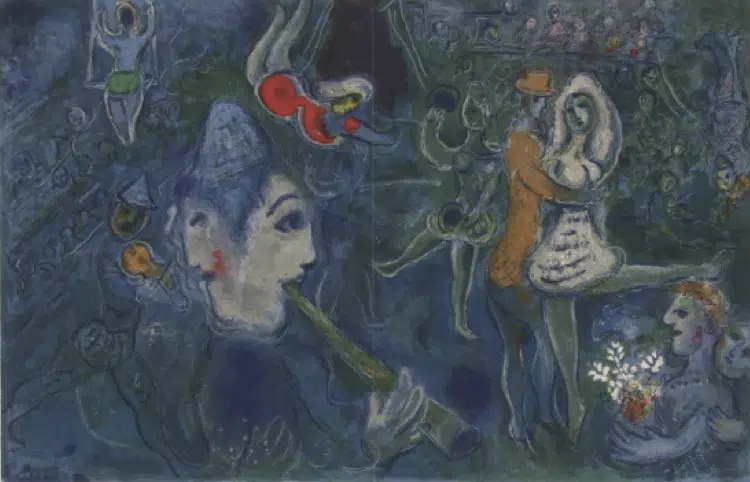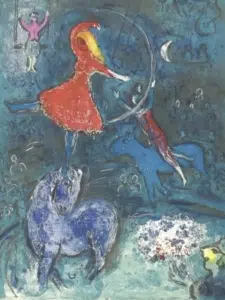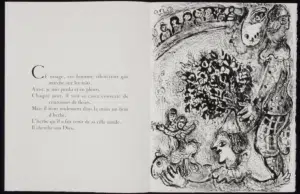
84.7.2, M-517
The following article was written by Diana Bolander, Assistant Director/Curator at the Rahr-West Art Museum.
Currently the Rahr-West Art Museum features an exhibit of Marc Chagall’s 1967 portfolio, Le Cirque. A recent tour group of middle school students were confused why the Museum was featuring this exhibit, as their main associations with the circus were allegations of animal abuse, terrifying clowns, and degrading sideshow acts. So why was Marc Chagall creating images of the circus in 1967 when he was eighty years old? What was the appeal?
One answer is that modern artists were often inspired by the circus. Alexander Calder, Walt Kuhn, George Seurat, and August Renoir often created art based on circus acts or the performers. The circus was a widely popular form of entertainment during Chagall’s lifetime and he created works based on the circus throughout his career. This was before the advent of the television, films on demand, and even widespread availability of zoos. Before the popularity and availability of zoos exploded in the 18th century, circuses would likely be the only outlet in which peoplewould see tigers, lions, or elephants in-person.
Chagall lived in Paris from 1911 – 1914, from 1923 – 1939, and then from 1948 to1985. Along with Ambroise Vollard, a French art dealer who had considerable influence on the development of French art in the early 20th century, Chagall frequently attended the French Circus. In 1927,Chagall produced 19 gouache paintings for Vollard on the Circus, a series commonly referred to as Cirque Vollard. The 1967 lithographs are based on these earlier gouaches. The Art Institute of Chicago houses a 1929 oil painting by Chagall titled The Circus Rider that further illustrates his interest in the subject. It can be seen online: https://www.artic.edu/artworks/118614/the-circus-rider. The piece has obvious connections to M-493 from the 1967 portfolio in coloration and subject (women riding on a horse while balancing on a horse; the inclusion of the moon).

The circus Chagall referenced and experienced in Paris is not the same circus we know in America. In Wisconsin, our associations with the circus are linked to the American tradition, and even perhaps to Baraboo, once the home of the massive enterprise of the Ringling BrothersCircus. Chagall’s associations were different. In Europe, the circus was more intimate, less of a spectacle, evident in Chagall’s writings. We see in M-502 how close the audience were to performers. Audience participation was an important part of the experience and clowns were not mute until much later. They often interacted and spoke directly to the audience.

84.24.2, M-502
Chagall called his dreams and visions of the circus “a magic and ephemeral sight, that passes like another world…the endless dance of the ages, where humans with their smiles and with the gestures of their arms and of their legs transform themselves into great art… Often they touch the sublime heights of poetry… It is in heaven that my circus performs.”

2016.1.3, M-501
Equestrian acts are featured prominently in Chagall’s prints, seen in M-493 and M-501. These acts were the core of the early modern circus, including dressage and acrobatic balancing acts. In 1766, talented British horseman Philip Astley (who is regarded as the father of the modern circus), began staging equestrian feats in London. He designed a ring-shaped amphitheater allowing horses to gallop in a circle. The centripetal and centrifugal forces could keep a standing rider from falling off the horse. He also introduced live music, jugglers, tightrope walkers and clowns. Astley was the first to don the traditional ringmaster’s costume of a red jacket and black boots, which signified the ringmaster as a skilled horseman as well. The word circus originates from the English word circle, the shape of the amphitheater. Astey opened Paris’ first circus in 1782. This is the tradition that Chagall responded to.
When reading the accompanying text in the Le Cirque portfolio, it becomes apparent Chagall is giving us images of the circus, though he is indeed referencing larger issues. For example, as a child in Russia in the 1890s, Chagall was fascinated by traveling acrobats at village fairs. He wrote about being transfixed by street performers in Vitebsk in his writings for the 1967 Le cirque portfolio and that “I do not know if anyone gave them even a penny…” He is talking about artists and the fear of not being able to make a living. The omnipresent fear of irrelevancy.
He questions his own fascination with the circus: “These clowns, these circus riders, these acrobats have settled in my visions. Why? Why do their make-up and their grimaces move me so? I approach with them toward horizons. Their colors and make-up lead me toward other psychic distortions, which I dream of painting. And when I see, in everyday life, a man who “plays” instead of living normally, I have the impression of evolving in a circus, but what a circus!” For Chagall, the parallels of the circus and life are marked.
True, some of the writings tend to ramble on, but Chagall continually talks about the circus in concert with great art and other modern artists such as Van Gogh, Don Quixote, Mozart, Kaftka, God and the Bible. He references life, the desire to keep living, and death. The clowns are his friends, they are philosophers and scientists. Lions and tigers are dissatisfied with “our human world.” The have contempt for “us and their prison.” The circus, for Chagall, is not for children, but is Art, is worthy of attention and intellectual exploration. These prints offer a glimpse into Chagall’s exploration. Indeed, for Chagall the world itself is Art if viewed from the perspective of connectedness.
Chagall: Le Cirque will be on exhibit at the Rahr-West Art Museum through February 13, 2022. The Rahr-West Art Museum is open, free to the public, Tuesdays – Fridays from 10:00 am – 4:00 pm and Saturdays and Sundays from 11:00 am – 4:00 pm. We are closed major holidays including Christmas Eve, Christmas Day, and New Year’s Day. Go to www.rahrwestartmuseum.org for more information on visiting, exhibitions, and events.
Images: Marc Chagall (1887-1985), Le Cirque Portfolio, 1967, Lithographs on arches woven paper, From the collection of the Rahr-West Art Museum, Gifts of Martin Katz and Museum Purchases










